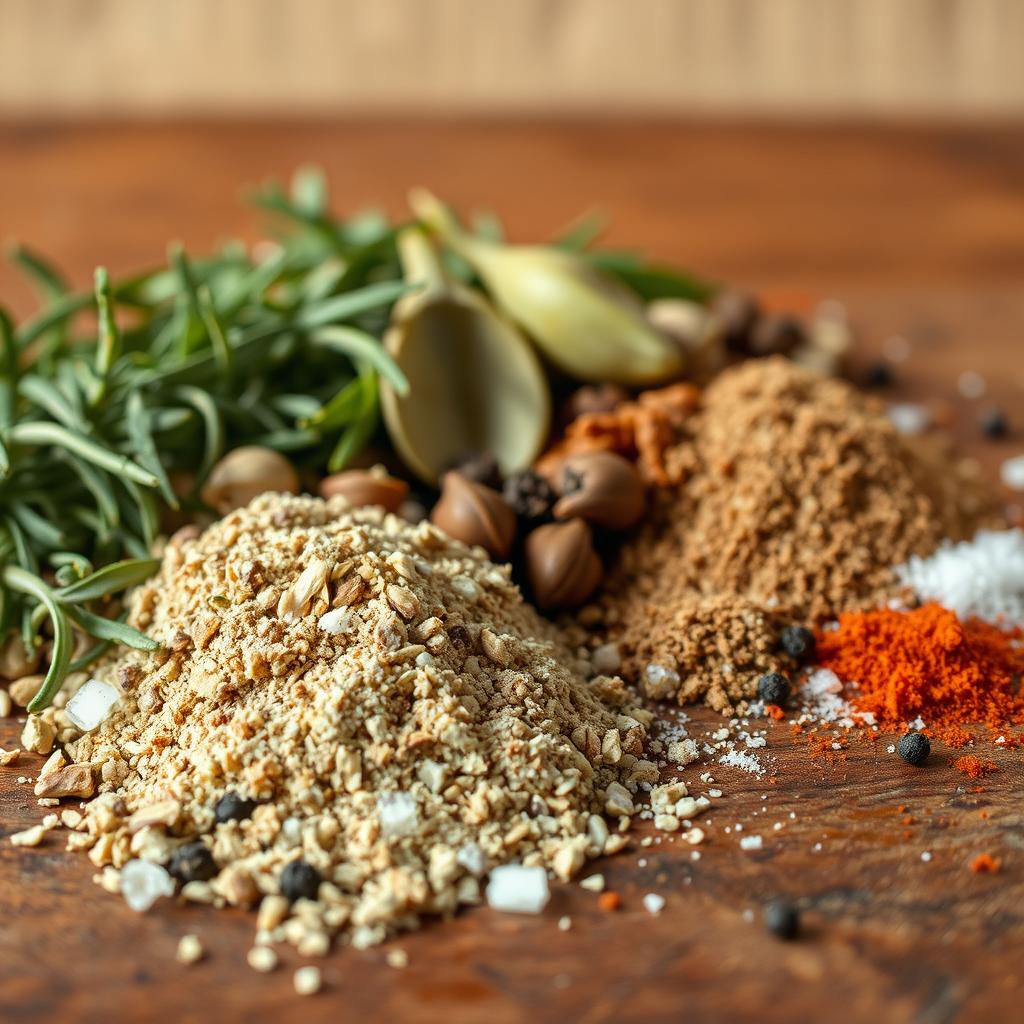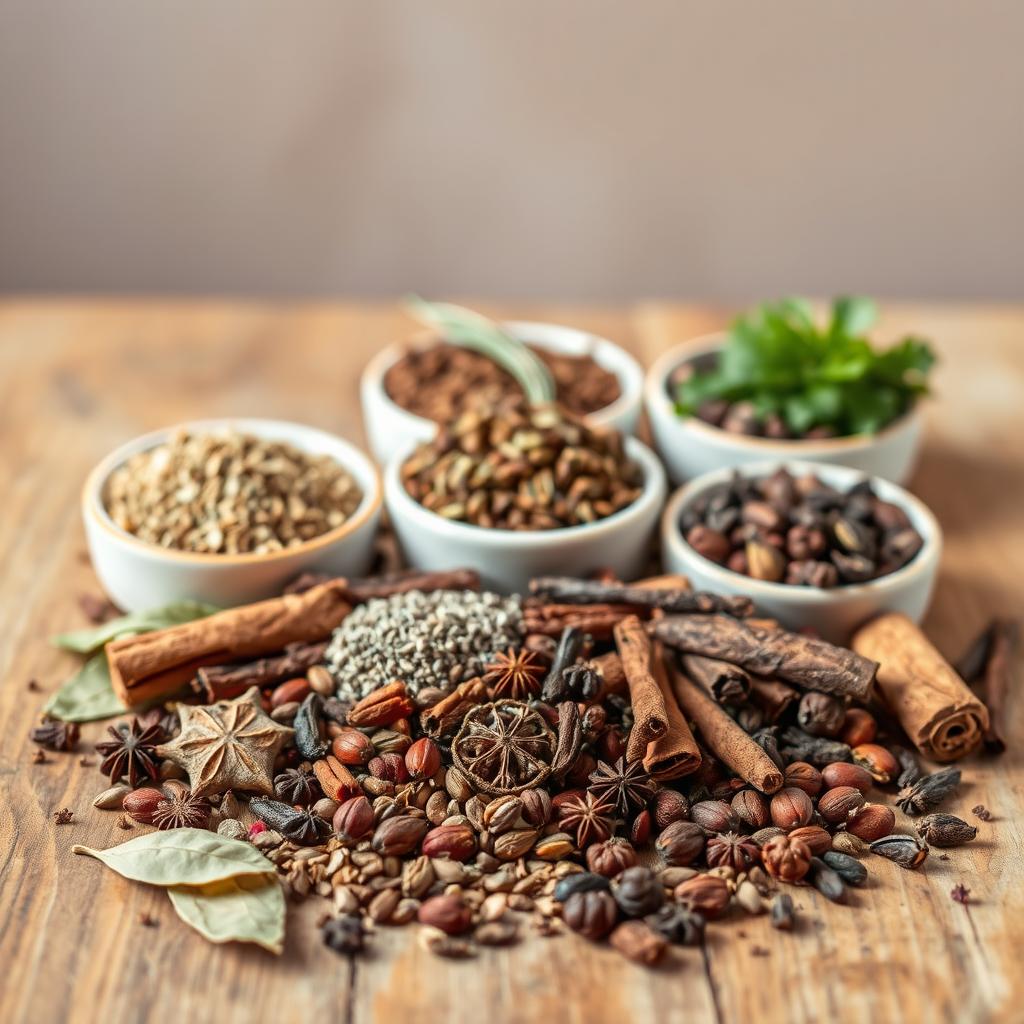A perfectly cooked pot roast is a true culinary delight. The right seasoning unlocks its full flavor potential.
Choosing the right seasoning blend can be tricky. There are countless options, from classic herb mixes to bold international flavors.
In this article, we’ll dive into some tasty pot roast seasoning ideas. Whether you’re an experienced chef or just starting out, you’ll find inspiration for new flavors.
Key Takeaways
- Discover the secret to a tender and flavorful pot roast
- Explore a variety of international seasoning blends
- Learn how to create your own custom seasoning mixes
- Get tips for pairing seasoning with different cooking methods
- Find inspiration for new and exciting pot roast recipes
The Art of Flavoring Tender, Juicy Pot Roasts
Learning to flavor a pot roast is a skill worth mastering. A great pot roast is more than just a meal. It’s a comforting experience that brings people together.
What Makes a Great Pot Roast Flavor Profile
A great pot roast flavor comes from a mix of spices, herbs, and other ingredients. These complement the beef’s natural flavor. The key is a balance of savory, sweet, and umami flavors.
- Savory flavors from ingredients like garlic and onion
- Herbs such as thyme and rosemary add depth
- A touch of sweetness from carrots or parsnips
The Science Behind Seasoning Tough Cuts of Meat
Seasoning tough cuts like pot roast involves understanding flavor penetration. Marinating or dry rubbing can enhance flavor.

Choosing the right pot roast seasoning or best pot roast seasoning blend is crucial. The goal is to balance flavors and let the meat cook slowly. This way, you get tender, juicy results.
Essential Ingredients for the Perfect Pot Roast Seasoning
To make your pot roast taste amazing, knowing the key ingredients is crucial. A good seasoning blend is the heart of a tasty dish.
Core Spices and Herbs Every Kitchen Needs
Every kitchen needs basic spices and herbs for seasoning. For pot roast, thyme, rosemary, and bay leaves are must-haves. They add depth and match the roast’s rich flavor.
- Thyme: Adds a slightly minty, earthy flavor
- Rosemary: Contributes a piney, aromatic note
- Bay leaves: Provide a mild, savory flavor
Salt and Pepper: Getting the Foundation Right
Salt and pepper are essential for any seasoning. Salt brings out the meat’s natural taste, and pepper adds a sharp kick. Using top-quality salt and freshly ground pepper really matters.
Aromatics That Enhance Depth and Complexity
Garlic and onion aromatics are key for depth and complexity. You can use powders or minced forms for ease. Garlic powder and onion powder offer strong flavors without the hassle.
Unexpected Ingredients That Make a Difference
For a unique twist, try adding smoked paprika or a bit of cayenne pepper. They bring a smoky or spicy touch that can take your dish to the next level.

By mixing these key ingredients, you can craft a homemade pot roast seasoning that’s both tasty and unique. Don’t be afraid to experiment with different amounts and extra ingredients to find your perfect blend.
How to Create Your Own Pot Roast Seasoning Blend
Making your own pot roast seasoning blend lets you try out different flavors. You can make it taste just how you like it. Plus, you get to use fresh, quality ingredients.
Step-by-Step Mixing Instructions
First, pick the spices and herbs you want to use. A basic mix might include paprika, garlic powder, onion powder, salt, black pepper, and dried thyme. Start by measuring out the ingredients for your recipe.
For a simple mix, use 2 tablespoons of paprika, 1 tablespoon of garlic powder, 1 tablespoon of onion powder, 1 tablespoon of salt, 1 teaspoon of black pepper, and 1 teaspoon of dried thyme in a bowl. Mix them well until they’re all combined.

Proper Storage Methods for Homemade Blends
After mixing, store your blend in an airtight container to keep it fresh. Glass jars or small plastic containers work well. Store it in a cool, dark spot like a pantry or cupboard.
Scaling Recipes for Different Roast Sizes
The amount of seasoning you need depends on the roast’s size. Here’s how to adjust your recipe:
Small Family Meals
For a 2-3 pound roast serving 4-6 people, use 2-3 tablespoons of seasoning.
Large Gatherings
For a 4-6 pound roast serving 8-12 people, use 4-6 tablespoons of seasoning.
| Roast Size (pounds) | Servings | Seasoning Blend Amount |
|---|---|---|
| 2-3 | 4-6 | 2-3 tablespoons |
| 4-6 | 8-12 | 4-6 tablespoons |
These guidelines help you make and use your own pot roast seasoning blend for any event.
Classic American Pot Roast Seasoning Recipes
Pot roast is a beloved dish in America, thanks to many seasoning recipes. These recipes reflect the country’s rich cultural heritage. Different regions have their own twists on traditional pot roast seasoning, using local flavors and ingredients.
Traditional Yankee Pot Roast Blend
The Northeast loves a hearty seasoning mix. A classic Yankee blend includes thyme, rosemary, and bay leaves. It also has salt, pepper, and a touch of garlic.
Southern Comfort Seasoning Mix
In the South, pot roast gets a special seasoning. It’s a mix of paprika, garlic powder, and onion powder. A bit of brown sugar adds sweetness to the savory flavors.

Midwestern Farmhouse Style
The Midwest uses fresh herbs from the garden in its pot roast seasoning. A typical blend has parsley, thyme, and dill. It’s seasoned with plenty of black pepper.
Cowboy-Inspired Western Rub
The West loves a bold, smoky flavor in its pot roast. A cowboy-inspired rub includes chili powder, cumin, and smoked paprika. It’s perfect for slow-cooking.
| Region | Key Ingredients | Flavor Profile |
|---|---|---|
| Northeast (Yankee) | Thyme, Rosemary, Bay Leaves | Herbaceous, Savory |
| South | Paprika, Garlic Powder, Onion Powder | Comforting, Slightly Sweet |
| Midwest | Parsley, Thyme, Dill | Fresh, Herbaceous |
| West | Chili Powder, Cumin, Smoked Paprika | Bold, Smoky |
These seasoning recipes highlight America’s diverse culinary traditions. Whether you’re from the Northeast or the West, you’ll find a pot roast seasoning that’s a family hit.
International Flavor Profiles for Your Pot Roast
Global flavors can make pot roast exciting. You can turn this comfort food into a journey around the world. Try herbs from Provence, spices from Italy, or umami from Asia for a new taste.
French Provençal Herb Combinations
French cooking loves fresh herbs. A Provençal mix of thyme, rosemary, and oregano with garlic and lavender is perfect. It brings the Mediterranean to your table.
Italian Countryside Seasoning Approach
Italian seasoning is all about dried herbs like basil and oregano. Add rosemary and parsley for a rich flavor. Garlic and onion powder make it even better, like a taste of Italy.
Mediterranean Spice Blends
The Mediterranean is famous for its spices. Cumin, coriander, and sumac are key. Mix these with thyme and oregano for a warm, exotic taste.
Asian-Fusion Flavor Innovations
Asian flavors can change pot roast. Try Chinese five-spice or Japanese soy sauce and ginger. These add exciting twists to the classic recipe.
Chinese Five-Spice Variation
Chinese five-spice has cinnamon, cloves, and more. It adds a complex flavor. Adjust the spices and add garlic powder for a pot roast twist.
Japanese-Inspired Umami Blend
Japanese food is all about umami. Mix thyme, rosemary, and parsley with soy sauce powder. It brings a deep, savory taste to your pot roast.
Applying Pot Roast Seasoning for Maximum Flavor
Getting the most flavor from your pot roast starts with how you season it. The method you use can greatly affect the taste. You might use a dry rub, a wet marinade, or a mix of both.
Dry Rub Application Techniques
A dry rub is a blend of spices and herbs rubbed on the meat. It can make the meat taste better and feel more tender. There are a few ways to apply a dry rub, depending on when you want the flavors to kick in.
Pre-Searing Seasoning
Applying the dry rub before searing the pot roast creates a flavorful crust. Coat the meat evenly with the rub, pressing it gently to make sure it sticks.
Post-Searing Additions
After searing, you can add more dry rub on top. This adds extra flavor, which is great for slow-cooked pot roast. The heat from searing helps the spices get deeper into the meat.
Wet Marinade Methods and Timing
A wet marinade soaks the pot roast in a liquid mix with seasoning. The acid in the marinade tenderizes the meat, while the spices and herbs add flavor. The longer you marinate, the more flavorful the pot roast will be.
Layering Flavors Throughout the Cooking Process
Layering flavors means seasoning at different cooking stages. Start with a dry rub, then add aromatics like onions and garlic. Finish with seasoning in the cooking liquid. This makes the pot roast flavorful all the way through, not just on the surface.
Finishing Touches Before Serving
Just before serving, add a final seasoning touch. This could be fresh herbs, a squeeze of citrus, or a flavored sauce. These touches can make the dish even better and add a nice brightness to the rich flavors of the pot roast.
Liquid Additions That Complement Your Pot Roast Seasoning
Adding the right liquids to your pot roast is crucial for a great meal. These liquids can make the flavors richer, tenderize the meat, and create a tasty sauce. This sauce is perfect for serving with your pot roast.
Wine and Alcohol Selection Guide
Wine is a top pick for deepening pot roast flavors. Red wines like Cabernet Sauvignon and Merlot work well. They match the bold tastes of the roast. Beer or dark ale can also be used for a unique, malty flavor.
Broth and Stock Flavor Profiles
Broth or stock adds moisture and taste to your pot roast. Beef broth is a favorite, but try chicken or vegetable stock for a lighter flavor. Homemade stock gives the best taste.
Acidic Components: Vinegars, Citrus, and Tomatoes
Acidic ingredients balance the richness of pot roast. Vinegar, like apple cider or balsamic, adds a tangy taste. Citrus juice, such as lemon, brightens the dish. Tomatoes add acidity and sweetness.
Sweet Elements: Honey, Maple, and Fruit Juices
Sweetness can balance savory flavors. Honey and maple syrup are great for glazing the roast. Fruit juices, like apple or cranberry, add a fruity twist.
Choosing and mixing these liquids carefully can make your pot roast both flavorful and complex. Try different mixes to find your favorite.
Seasonal Pot Roast Seasoning Ideas
Seasonal ingredients open up a world of unique pot roast seasoning blends. Using fresh, seasonal elements can make your pot roast dishes stand out. This keeps your meals exciting all year round.
Spring Herb-Forward Blends
In spring, brighten your pot roast with herb-forward blends. Use fresh herbs like parsley, chives, and tarragon. These light flavors pair well with spring lamb or beef.
- Mix minced fresh parsley with garlic, lemon zest, and a pinch of salt for a simple yet flavorful seasoning.
- Combine chives with dried thyme and a hint of paprika for a subtle, earthy taste.
Summer Bright and Zesty Combinations
Summer is the perfect time for bright, zesty flavors in your pot roast. Add citrus zest, chili flakes, or fresh cilantro for a vibrant twist.
“The key to a great summer pot roast is balancing the richness of the meat with bold, fresh flavors.”
Fall Harvest Warming Spices
As fall comes, warm up your pot roast with harvest spices. Cinnamon, nutmeg, and allspice add depth and warmth.
- Blend ground cinnamon with brown sugar and a hint of smoked paprika for a sweet and savory flavor.
Winter Comfort Food Seasonings
In winter, choose comforting, hearty seasonings for your pot roast. Bay leaves, cloves, and star anise create a cozy flavor.
Adapting your pot roast seasoning to the season keeps meals fresh and exciting. Try different ingredients and flavors to find your new favorite pot roast recipe.
Troubleshooting Common Pot Roast Seasoning Mistakes
Don’t let seasoning mistakes ruin your pot roast – learn how to identify and fix them quickly. Even with a top-rated pot roast seasoning mix, things can go wrong. Here’s how to troubleshoot common issues.
Fixing Over-Seasoned Pot Roast
If your pot roast is too salty or overpowering, there are a few remedies you can try. Adding a dairy product like sour cream or yogurt can help neutralize the flavors. You can also add more of the other ingredients in the recipe to balance out the seasoning.
Remedies for Under-Seasoned Meat
If your pot roast is under-seasoned, you can try adding more seasoning directly to the meat or to the cooking liquid. Be cautious not to overdo it, as it’s easier to add more seasoning than it is to remove excess.
Balancing Competing Flavors
When using a complex pot roast seasoning mix, flavors can sometimes clash. To balance competing flavors, try adjusting the amount of a particular spice or herb. You can also add a sweet or acidic element to counterbalance the other flavors.
Adjusting Seasoning for Different Cooking Methods
The cooking method can significantly impact the final flavor of your pot roast. Here are some adjustments to make for different cooking techniques:
Slow Cooker Considerations
When using a slow cooker, flavors tend to meld together and intensify over time. Start with a lighter hand when seasoning, as you can always add more later.
Dutch Oven Techniques
Dutch ovens allow for browning and crisping, which can enhance flavors. Consider adding aromatics like onions and garlic to the pot for added depth.
Pressure cooking can result in a more intense flavor. Be cautious not to over-season, as the flavors will concentrate during cooking.
Conclusion: Elevating Your Meals with Perfect Pot Roast Seasoning
Learning to make the perfect pot roast seasoning can turn a simple meal into a work of art. It shows how important the right mix is. Home cooks can make their meals special and create memories with it.
Seasoning pot roast is easy, no matter if you’re new to cooking or have years of experience. By using the tips and ideas shared, you can explore many flavors. Every dish becomes a chance to wow and please your guests.
FAQ
What is the best pot roast seasoning blend?
The best seasoning blend for pot roast is up to you. A classic mix includes thyme, rosemary, garlic powder, onion powder, salt, and pepper. You can also try French Provençal or Italian countryside flavors.
How do I create my own homemade pot roast seasoning?
Start by mixing thyme, rosemary, and oregano. Add garlic powder and onion powder. Then, adjust with salt and pepper to taste. You can also tailor it for different roast sizes and cooking methods.
What are some unexpected ingredients that can enhance pot roast flavor?
Coffee or cocoa powder can add depth. Citrus zest or juice brings a tangy contrast. Try vinegar or brown sugar to balance the flavors.
How do I apply pot roast seasoning for maximum flavor?
Use dry rubs, wet marinades, and layer flavors during cooking. Finish with fresh herbs or citrus juice for extra flavor.
What are some common pot roast seasoning mistakes, and how can I fix them?
Mistakes include over- or under-seasoning. To fix, adjust seasoning or add liquid. Different cooking methods can also help.
Can I use pot roast seasoning for other dishes?
Yes, it’s great for roasted veggies, stews, or braises. Try it on chicken or lamb for new flavors.
How do I store homemade pot roast seasoning blends?
Store them in an airtight container in a cool, dark place. You can also refrigerate or freeze to keep flavors fresh.
Can I customize pot roast seasoning for different cooking methods?
Yes, adjust the blend for slow cooking, braising, or roasting. Choose based on the desired tenderness.
What are some seasonal pot roast seasoning ideas?
Use herb-forward blends in spring, zesty flavors in summer, warming spices in fall, and comfort seasonings in winter. Match flavors to the season.




